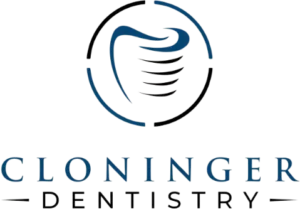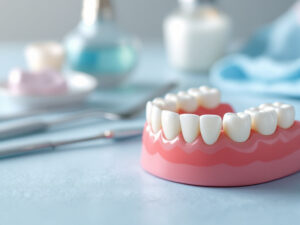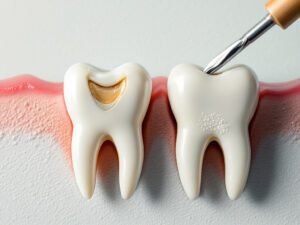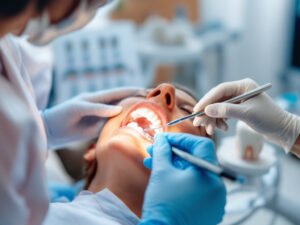Common dental damage
If you’ve been researching dentistry for damaged teeth, you’re in the right place. In everyday life your teeth can chip, crack, decay or even go missing, and each type of damage calls for a specific solution. With restorative dentistry you can regain function, comfort and confidence in your smile.
Below you’ll learn how to identify common dental damage, compare direct and indirect restoration options and plan a treatment path that fits your needs.
Chips and fractures
Teeth may chip or crack from teeth grinding, chewing hard foods, sports injuries or sudden temperature changes (Cleveland Clinic). You might notice:
- Sharp pain when biting
- Sensitivity to hot or cold
- Visible lines or fragments
If a crack extends into the tooth pulp, bacteria can cause an abscess that spreads to bone or soft tissues (Cleveland Clinic). To prevent further harm, seek a repair cracked tooth dentist as soon as you spot symptoms.
Decay and cavities
Cavities are decayed areas on the tooth surface that deepen over time without treatment (Mayo Clinic). Early on you may not feel pain, but as decay reaches inner layers you can experience:
- Persistent toothaches
- Sensitivity during eating
- Dark spots or holes
Good oral hygiene and regular checkups catch cavities before they worsen. When decay appears, a skilled tooth filling dentist can restore the tooth structure and stop infection.
Missing teeth
Losing a tooth affects chewing, speech and the alignment of remaining teeth. Over time, bone in the jaw can deteriorate without the stimulation of a root. Missing teeth may also impact self-esteem and social interactions.
Restoring gaps promptly preserves your facial structure and oral health. You have several options, from bridges to implants—each designed to replace missing teeth and prevent further problems.
Direct restoration options
When damage is limited to a portion of the tooth, direct restorations let your dentist repair it in one visit. These procedures bond material to the existing tooth to rebuild its shape and strength.
Composite fillings
Composite fillings use tooth-colored resin that blends with your natural enamel. Benefits include:
- Aesthetic match to surrounding teeth
- Conservative preparation, preserving more healthy structure
- Strong bonding to enamel and dentin
Your dentist applies the resin in layers, hardening each with a curing light. Once shaped and polished, your tooth looks and functions normally. To learn more, see our composite filling service.
Benefits of composite
- Minimal metal sensitivity
- Less temperature sensitivity than metal fillings
- Repairs small chips along with cavities
Process overview
- Numb the area with local anesthesia
- Remove decayed or damaged enamel
- Layer and cure composite resin
- Shape, polish and check your bite
Other filling materials
Beyond composite, options include amalgam (silver), gold or porcelain. Amalgam is durable and cost-effective but less discreet. Porcelain inlays and onlays resist staining but often require lab fabrication and multiple visits.
Indirect restoration options
When more extensive repair is needed, indirect restorations are crafted outside the mouth then bonded or cemented in place. They protect and strengthen the entire tooth.
Dental crowns
Crowns cap a weakened or broken tooth, restoring its shape, size and function. Common crown types include porcelain, metal or porcelain-fused-to-metal.
After preparing your tooth, your dentist takes an impression to create a custom crown. You’ll wear a temporary cap until the final crown is ready. Learn about placement at dental crown placement.
Porcelain crowns
Porcelain crowns deliver the most natural appearance, mimicking the translucence of enamel. They resist stains and are biocompatible. For a full overview, visit porcelain crown restoration.
Placement procedure
- Remove old filling or decay and shape the tooth
- Take digital or physical impressions
- Place a temporary crown
- Cement the final crown after fit and color confirmation
Dental bridges
A bridge fills the gap left by one or more missing teeth, anchoring to adjacent natural teeth or implants. Types include fixed, cantilever and Maryland bridges.
| Bridge type | Support structure | Ideal use case |
|---|---|---|
| Fixed bridge | Crowns on both sides | Single missing tooth or two |
| Cantilever | One adjacent crown | Limited options for support |
| Maryland | Metal or porcelain wings | Preserve minimal enamel removal |
Your dentist will assess healthy teeth on either side of the gap. After preparing them for crowns, the bridge is custom-made and then cemented in a single appointment. To explore services, see dental bridge replacement or learn about crown and bridge dentistry.
Advanced repair services
For complex damage or missing roots, your dentist may recommend restorative procedures that go beyond fillings and crowns.
Implant restorations
Dental implants replace both the root and crown of a missing tooth. A titanium post is surgically placed into the jawbone, where it fuses over several months. Once stable, your implant is topped with an abutment and crown to fully restore chewing and appearance.
The total cost of an implant, abutment and crown can range from $3,100 to $5,800 (American Dental Association’s Health Policy Institute via Humana). For specialized care, consult an implant restoration dentist.
Root canal therapy
When damage or decay reaches the tooth’s pulp, you may experience severe pain and swelling. Root canal therapy removes infected tissue, disinfects the canal and seals it to prevent reinfection. Often a crown is placed afterward to reinforce the treated tooth. Find details at root canal therapy.
Denture services
If multiple teeth are missing, full or partial dentures can restore function and aesthetics. Options range from removable appliances to implant-supported overdentures. Costs vary widely—from about $452 for low-cost dentures up to $6,514 for premium sets—depending on materials and customization (CareCredit). Explore our custom denture services to find the right fit for you.
Planning your treatment
Before beginning any procedure, it helps to understand cost, coverage and provider qualifications.
Cost considerations
Your initial exam, cleaning and X-rays typically cost around $203 on average, with a national range of $50 to $350 (CareCredit). Restoration costs vary by procedure, material and location. Ask your dentist for a personalized estimate and itemized breakdown.
Insurance and financing
Many dental plans cover at least part of restorative procedures. Check your benefits and use an insurance covered restorative dental provider to maximize coverage. For out-of-pocket expenses, inquire about payment plans, in-office financing or third-party lenders.
Choosing a provider
Select a dentist or specialist with experience in restorative dentistry. Look for credentials such as board certification, continuing education in cosmetic and implant dentistry and patient reviews. Visit a dental restoration clinic that offers a full suite of restorative dental procedures and dental prosthetics services.
Maintaining restoration longevity
Once your teeth are repaired, proper care helps ensure lasting results.
Oral hygiene practices
- Brush twice daily with fluoride toothpaste to strengthen enamel and reverse early decay (NIH).
- Floss daily to remove plaque between teeth and under bridges.
- Consider chewing xylitol gum to slow bacterial growth and reduce decay risk (WebMD).
- Avoid chewing ice, pens or hard candies that may chip restorations.
Regular dental checkups
Schedule biannual visits for professional cleanings and exams. Your dentist can detect wear, loosened crowns or early signs of new damage. Prompt repairs of minor issues prevent more extensive work later. If a restoration chips or cracks, you can have it fixed quickly through repair broken dental work.
By understanding your options and taking an active role in planning and care, you can restore damaged teeth effectively and enjoy a functional, beautiful smile for years to come. For personalized guidance on repair, fillings and crowns, talk with your dentist and explore services like tooth repair and restoration.










